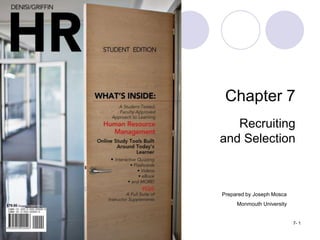More Related Content
Similar to Denisi hr 1e_ch.07_student (1) (20)
Denisi hr 1e_ch.07_student (1)
- 1. Copyright © 2012 by Cengage Learning. All rights reserved.
7- 1
Chapter 7
Recruiting
and Selection
Prepared by Joseph Mosca
Monmouth University
- 2. Copyright © 2012 by Cengage Learning. All rights reserved.
7- 2
Learning Objectives
1. Describe the relationship among planning, recruiting, and
selection.
2. Identify and discuss the basic sources for recruiting; discuss
realistic job previews and their role in effective recruiting.
3. Describe the steps in the selection process and identify and
summarize basic selection criteria that organizations use in hiring
new employees.
4. Discuss popular selection techniques that organizations use to
hire new employees.
5. Discuss the selection decision itself.
6. Describe reliability and validity and their importance in employee
selection.
7. Identify and summarize the basic legal issues in selection and
discuss the importance of evaluating recruiting and selection
activities.
- 3. Copyright © 2012 by Cengage Learning. All rights reserved.
7- 3
Recruiting
Recruiting is the
process of developing a
pool of qualified
applicants who are
interested in working for
the organization and
from which the
organization might
reasonably select the
best individual or
individuals to hire for
employment.
- 4. Copyright © 2012 by Cengage Learning. All rights reserved.
7- 4
Methods for External Recruiting
Word of
mouth
Advertisements
Employment agencies
•Private
•Public
•Executive search
firms/headhunters
College
placement
offices
Electronic
recruiting
Techniques
for
Recruiting
- 5. Copyright © 2012 by Cengage Learning. All rights reserved.
7- 5
Big 5 Personality Traits
Big 5 Personality Traits: These tend to be
more behavioral than cognitive or
emotional and are likely to be more
important for job performance than more
traditional personality traits:
1. Neuroticism
2. Extraversion
3. Openness to experience
4. Agreeableness
5. Conscientiousness
- 6. Copyright © 2012 by Cengage Learning. All rights reserved.
7- 6
Employment Applications
An employment
application asks
individuals for
various bits of
information
pertaining to their
personal
background.
- 7. Copyright © 2012 by Cengage Learning. All rights reserved.
7- 7
Employment Applications (con’t)
Weighted application blanks rely on the
determination of numerical indices to
indicate the relative importance of various
personal factors for predicting a person’s
ability to perform a job.
Biodata application blanks focus on the
same type of information that is found in a
regular application, but go into more
complex detailed background assessment.
- 8. Copyright © 2012 by Cengage Learning. All rights reserved.
7- 8
Employment Tests
Employment tests are a device for measuring
the characteristics of an individual, such as
personality, intelligence, or aptitude.
Cognitive ability tests measure mental skills
whereby the applicant is not required to do anything
physical, only to demonstrate some type of
knowledge.
Psychomotor ability tests measure physical abilities
such as:
Strength
Eye-hand coordination
Mental dexterity
- 9. Copyright © 2012 by Cengage Learning. All rights reserved.
7- 9
Employment Tests (con’t)
Personality tests measure traits, or tendencies
to act, that are relatively unchanging in a person.
A self-report inventory is a paper-and-pencil
measure where an applicant responds to a series
of statements that might or might not apply to the
applicant.
The projective technique involves showing an
individual an ambiguous stimulus, such as an ink
blot or a fuzzy picture, and then asking what he or
she “sees.”
- 10. Copyright © 2012 by Cengage Learning. All rights reserved.
7- 10
Personal Interviews
One of the most widely used selection
techniques which are face-to-face
conversations between prospective job
applicants and representative of the
organization.
- 11. Copyright © 2012 by Cengage Learning. All rights reserved.
7- 11
Types of Interviews
Structured employment interview: the
interviewer either prepares or is given by others a
list of standard questions to be asked during the
interview. All interviewers ask the same questions
of each candidate to achieve consistency across
interviews.
Semi-structured employment interview: the
interviewer may have a general idea about the job
applicant, but has a few or no advance questions
that are formally constructed and ready to be
asked.
- 12. Copyright © 2012 by Cengage Learning. All rights reserved.
7- 12
Types of Interviews (con’t)
Unstructured
employment interview:
the interviewer may have
a general idea about what
s/he wants to learn about
the applicant but has few
or no advance questions
prepared.
Situational interview:
the interviewer asks the
applicant questions about
a specific situation to see
how the s/he will react.
- 13. Copyright © 2012 by Cengage Learning. All rights reserved.
7- 13
Interview Errors
First impression error occurs when an
interviewer makes a decision too early in the
interview process.
Contrast error is when the interviewer is
influenced by other interviewees.
Similarity error occurs when the interviewer
is influenced because the interviewee is similar
to the interviewer.
Non-relevancy is when the interviewer does
not know enough about the job.
- 14. Copyright © 2012 by Cengage Learning. All rights reserved.
7- 14
Reliability and Validity
Reliability: the consistency of a particular
selection device; not the same as
accuracy
Validity: refers to whether an assessment
tool measures what it is supposed to; this
must be determined empirically, and it is
critical to defending against charges of
discrimination in hiring.
- 15. Copyright © 2012 by Cengage Learning. All rights reserved.
7- 15
Legal and Effectiveness Issues in
Recruiting and Selection
Helping the organization defend itself in
discrimination cases is one of the most
important areas in which the human
resource manager can make a
contribution to the firm.
